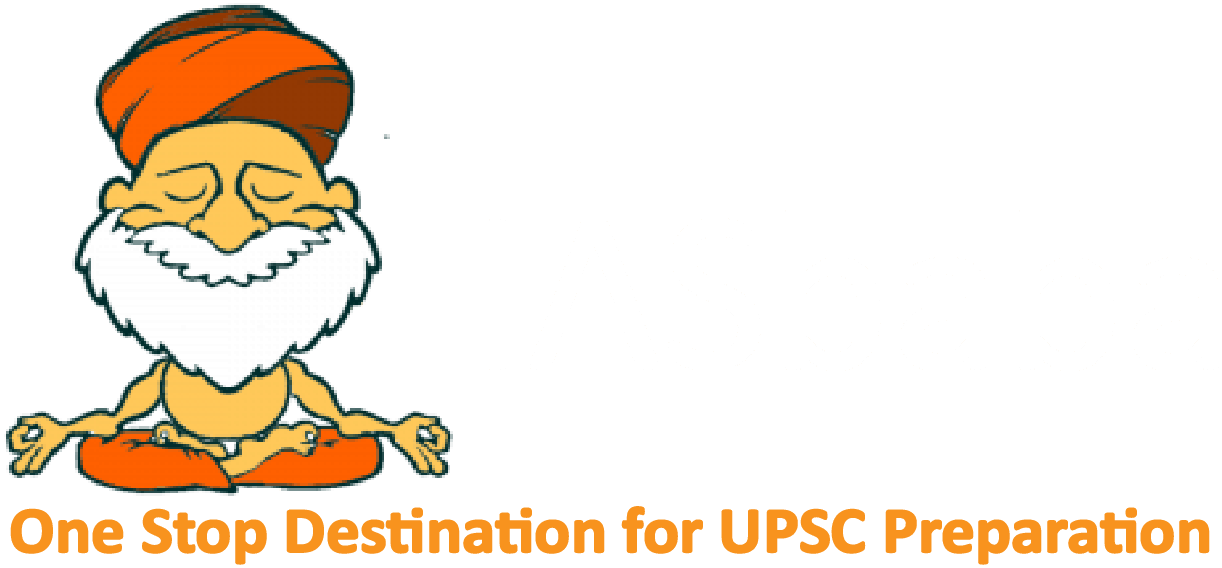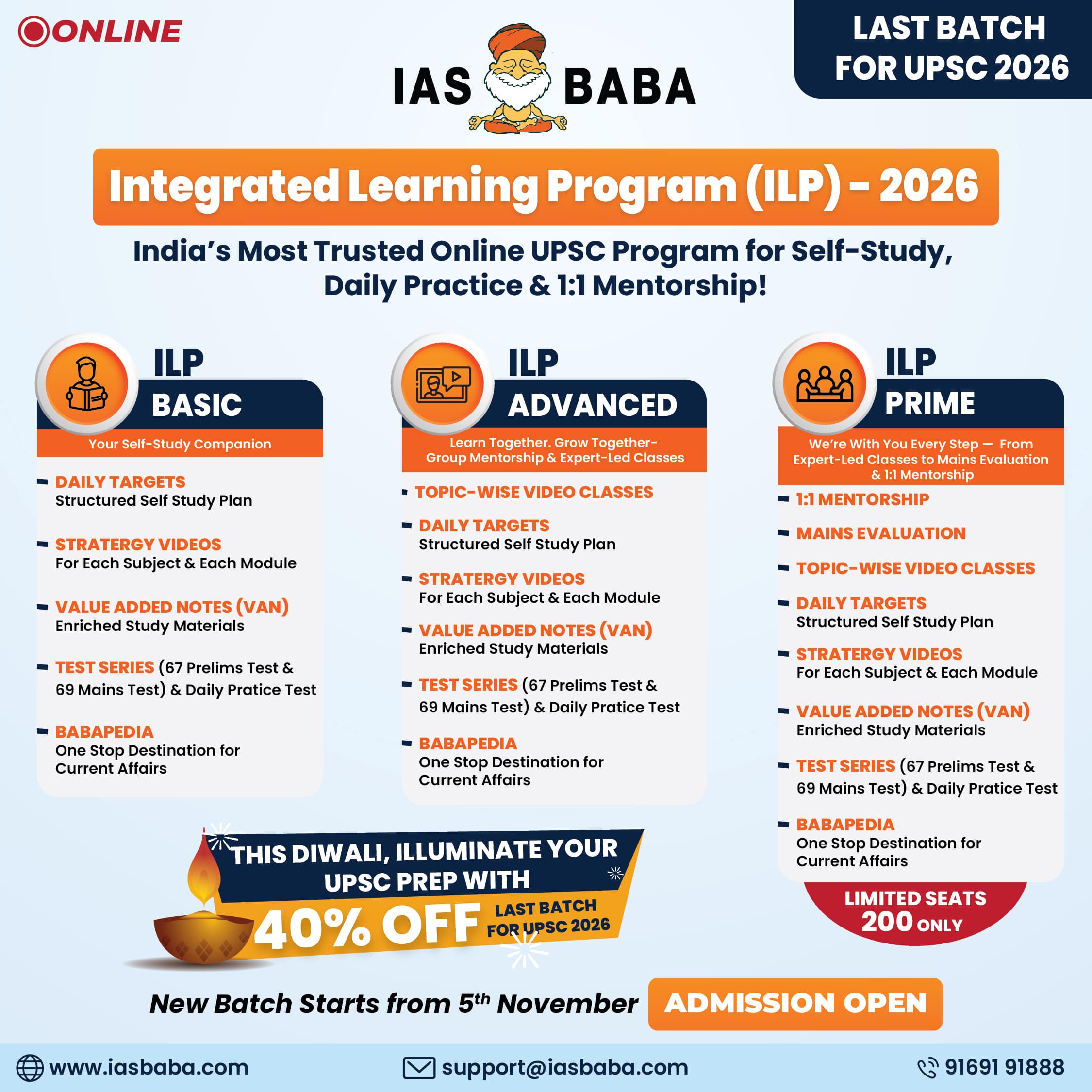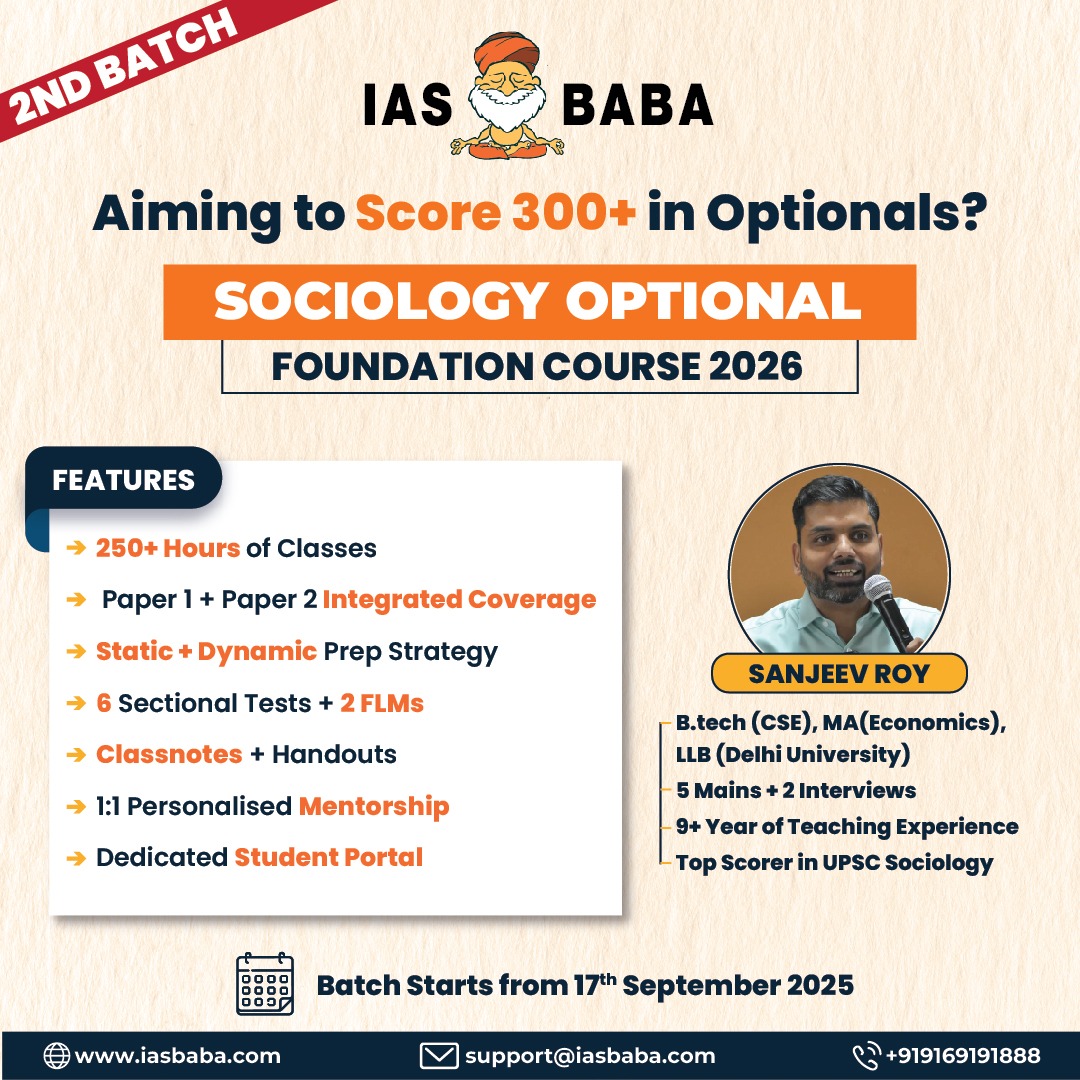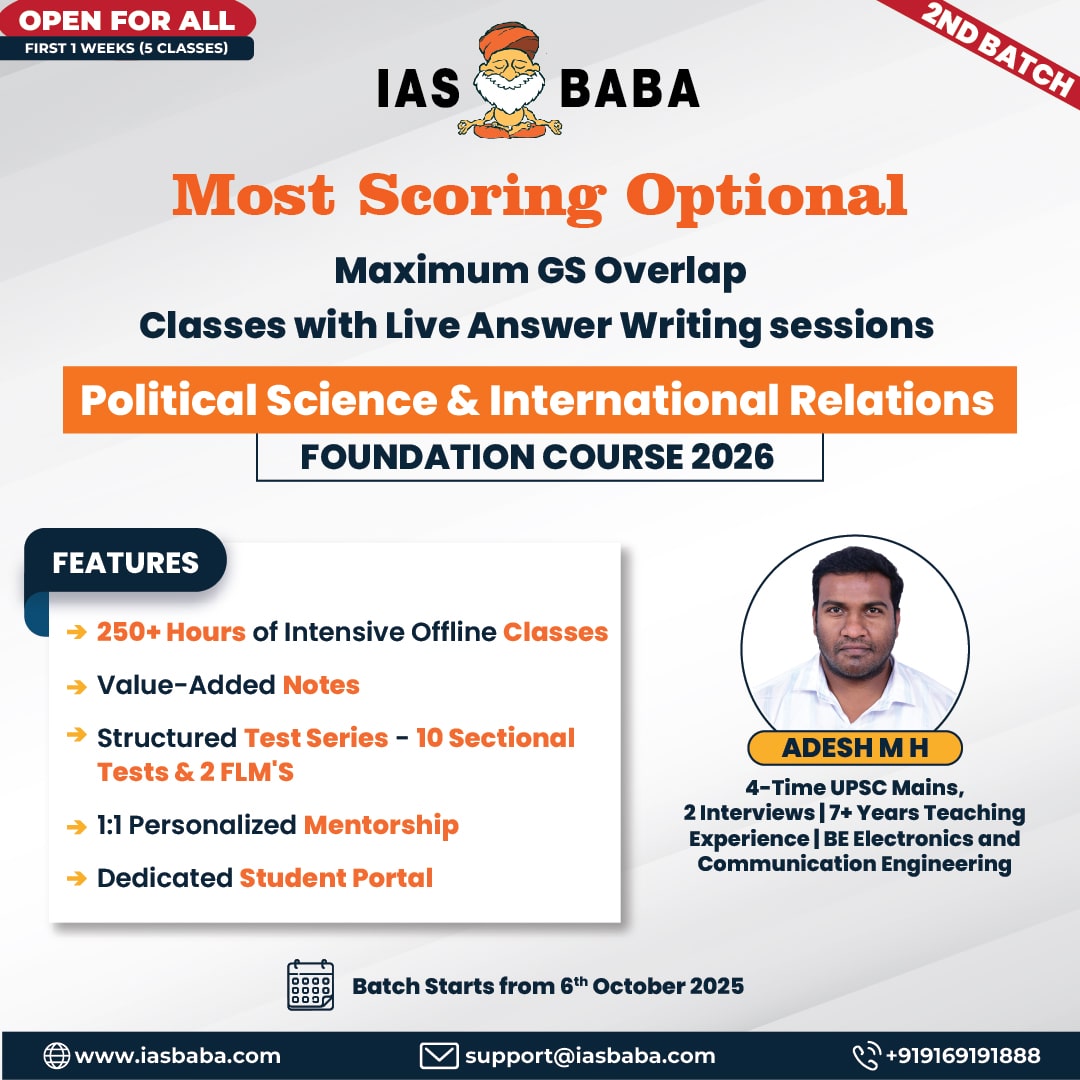IASbaba's Daily Current Affairs Analysis
rchives
(PRELIMS Focus)
Category: SCIENCE AND TECHNOLOGY
Context: Can be directly asked in Prelims.
- Purpose & Use
- Normal laptops handle daily tasks like browsing or essays.
- Supercomputers solve massive, complex, calculation-heavy problems—e.g., weather forecasting, simulating nuclear reactions, modelling the early universe.
- How They Work
- Use parallel computing: thousands of processors work simultaneously.
- Each processor tackles a small part of a problem, combining results into one solution.
- Require special infrastructure: high-speed networks, bespoke cooling (pipes, refrigeration, or special liquids).
- Structure (Organised in Layers)
- Processors: CPU + GPU (for parallel operations, simulations, scientific computations).
- Nodes: Groups of processors bundled together.
- Network: High-speed connections linking nodes, with Internet connections for remote access.
- Software
- Specialised software divides large problems into tasks across many processors.
- Users write scripts describing required computing and expected outputs.
- Outputs (numbers, images, simulations) stored and used for analysis.
- India’s Supercomputing Journey
- Began in the late 1980s when Western countries refused to export high-end machines.
- Led to the creation of C-DAC (1988).
- Developed PARAM series (from 1991).
- Now part of the National Supercomputing Mission (NSM), which aims to build ~70 supercomputers across India.
- Used in IITs, IISERs, IISc, and key institutes for weather forecasting, drug discovery, space research, AI models, etc.
- Future Outlook
- Quantum computers could surpass supercomputers in handling certain problems.
- European Commission has invested in exascale supercomputers (10¹⁸ operations/sec).
- India continues building indigenous systems for scientific research and strategic needs.
Learning Corner:
India’s Supercomputing Journey
- Background (1980s)
- In the late 1980s, Western countries, especially the U.S., refused to export high-end supercomputers to India due to technology embargoes.
- This triggered India’s indigenous supercomputing programme.
- C-DAC Establishment (1988)
- The Centre for Development of Advanced Computing (C-DAC) was set up in 1988 by the Government of India to build domestic supercomputing capabilities.
- PARAM Series
- India’s first supercomputer PARAM 8000 was launched in 1991.
- It marked India’s entry into the global supercomputing community.
- The PARAM series evolved with improved speed and capacity over the years.
- Expansion (2000s onwards)
- Supercomputers were installed across IITs, IISc, IISERs, and national laboratories.
- Used for weather forecasting, climate modelling, molecular biology, drug discovery, space research, AI, and defence applications.
- National Supercomputing Mission (NSM)
- Launched in 2015 as a joint initiative of the Department of Science and Technology (DST) and the Ministry of Electronics and IT (MeitY), implemented by C-DAC and IISc.
- Aims to build 70+ high-performance computing (HPC) facilities across India, with indigenous hardware and software development.
- Recent Progress
- Supercomputers like Pratyush and Mihir have been deployed for weather and climate research.
- India is moving towards petascale and exascale computing capabilities.
Source: THE HINDU
Category: INTERNATIONAL
Context : President Donald Trump announced an increase in H-1B visa fees to $100,000.
- Decision by U.S. Government
- The White House later clarified:
- It is a one-time fee, not an annual charge.
- Applies only to fresh H-1B visa applicants (next upcoming lottery cycle).
- Does not apply to renewals or existing visa holders re-entering the U.S.
- The White House later clarified:
- Reason & Remarks
- U.S. Commerce Secretary Howard Lutnick initially created confusion by suggesting the fee might be annual.
- He justified the fee saying tech companies should stop training foreign workers and instead train American graduates.
- Impact on Indian H-1B Holders
- The announcement caused panic among Indian H-1B visa holders outside the U.S., leading to a surge in last-minute flight bookings before the fee clarification.
- Travel agents reported a rush to return before the proclamation took effect on September 20–21, 2025 midnight.
Learning Corner:
Types of U.S. Visas
U.S. visas are broadly classified into two categories:
- Non-Immigrant Visas (temporary stay)
Issued for travel, study, business, or work on a temporary basis. Some major types:
- B-1 / B-2 Visa – For business (B-1) and tourism/medical treatment (B-2).
- F-1 Visa – For students enrolled in U.S. academic institutions.
- J-1 Visa – For exchange visitors, scholars, researchers, and interns.
- H-1B Visa – For skilled workers in specialty occupations (IT, engineering, etc.).
- H-2B Visa – For temporary or seasonal non-agricultural workers.
- L-1 Visa – For intra-company transferees (executives, managers, specialized knowledge staff).
- O Visa – For individuals with extraordinary ability in sciences, arts, education, business, or athletics.
- P Visa – For athletes, artists, and entertainers.
- R-1 Visa – For religious workers.
- Immigrant Visas (permanent stay – leads to Green Card)
For individuals intending to live permanently in the U.S.
- Family-sponsored visas – For spouses, children, parents, or siblings of U.S. citizens or permanent residents.
- Employment-based visas (EB-1 to EB-5) – For workers with extraordinary abilities, professionals, skilled/unskilled workers, and investors.
- Diversity Visa (DV) Lottery – Known as the “Green Card Lottery,” for nationals of countries with low immigration to the U.S.
- Special Immigrant Visas (SIV) – For specific categories like Afghan/Iraqi interpreters who assisted U.S. forces.
Source: THE HINDU
Category: SCIENCE AND TECHNOLOGY
Context: Astronomers have spotted the biggest bangs since the Big Bang.
- Discovery
- Astronomers from the University of Hawaii’s Institute for Astronomy (IfA) have identified a new category of cosmic events called Extreme Nuclear Transients (ENTs).
- ENTs are more powerful than gamma-ray bursts (GRBs), previously thought to be the most energetic events in the universe.
- What are ENTs?
- ENTs occur when stars stray too close to supermassive black holes in galactic centers.
- Extreme gravitational forces stretch and compress the star into a long stream (“spaghettification”), releasing massive electromagnetic energy.
- ENTs can be up to 10 times more energetic than the brightest previously known explosions.
- Rarity & Observation
- ENTs are far rarer than Tidal Disruption Events (TDEs), which are already uncommon.
- Their immense brightness makes them detectable across vast cosmic distances.
- Data from the Gaia spacecraft helped detect and study these phenomena.
- Significance
- ENTs are considered the biggest explosions since the Big Bang.
- They offer astronomers a new way to study black holes, galactic centers, and the evolution of the universe.
- ENTs differ from GRBs as they last much longer and are not just bursts but sustained emissions of energy.
- Future Prospects
- With new telescopes like the Vera C. Rubin Observatory and the Nancy Grace Roman Space Telescope, astronomers expect to detect more ENTs.
- Studying ENTs may help understand supermassive black holes, cosmic structure, and the physics of extreme energy.
Source: THE HINDU
Category: INTERNATIONAL
Context The United Nations General Assembly (UNGA) meets annually in New York. This year marks its 80th session.
- Speaking Tradition
- Brazil traditionally speaks first, followed by the United States (as host country).
- The speaking list is based on hierarchy and a first-come-first-served basis.
- Though speeches are ideally limited to 15 minutes, leaders often exceed this.
- Key Issues Likely to Dominate
- Gaza: Escalating humanitarian crisis and worsening famine. Israeli PM Netanyahu will address this.
- Ukraine: President Volodymyr Zelenskyy will seek global support against Russia’s invasion.
- Syria: Ongoing civil war, with rebel groups challenging Bashar al-Assad.
- Sudan: Continued conflict between the army and paramilitary RSF, leading to humanitarian concerns.
- Human rights, development, peace, and cooperation are the broader UNGA themes.
- Palestinian Leadership
- Palestinian President Mahmoud Abbas will not attend; the U.S. has ruled out giving him a visa.
- Leadership Changes
- Next year, the UN will choose a new Secretary-General as António Guterres completes his second term.
- Also, five countries will be elected as non-permanent members of the UN Security Council (including likely candidates like Britain, China, Russia, and the U.S. continuing as permanent members).
Learning Corner:
United Nations (UN)
- Establishment
- Founded on 24 October 1945 after World War II to promote peace and prevent future conflicts.
- Replaced the League of Nations.
- Headquarters: New York, USA.
- Current Membership: 193 countries.
- Founding Principles (UN Charter)
- Maintain international peace and security.
- Develop friendly relations among nations.
- Promote human rights and fundamental freedoms.
- Foster international cooperation in solving economic, social, cultural, and humanitarian problems.
- Main Organs
- General Assembly (UNGA): All members, deliberative body, each country has one vote.
- Security Council (UNSC): Maintains peace and security; 15 members (5 permanent with veto – US, UK, Russia, China, France + 10 non-permanent elected for 2 years).
- International Court of Justice (ICJ): Judicial organ, settles disputes between states; located at The Hague.
- Economic and Social Council (ECOSOC): Coordinates social, economic, humanitarian work.
- Trusteeship Council: Inactive since 1994 (after Palau gained independence).
- Secretariat: Administrative organ headed by the Secretary-General (currently António Guterres, term till 2026).
- Specialized Agencies & Programs
- UNICEF, WHO, UNESCO, FAO, ILO, IMF, World Bank, UNHCR, WFP, UNEP, UNDP, etc.
- Work in health, development, humanitarian aid, climate change, refugees, education, and global governance.
- Achievements
- Peacekeeping missions, decolonization, promotion of human rights (Universal Declaration of Human Rights, 1948), Sustainable Development Goals (SDGs).
- Challenges
- UNSC reform, veto power criticism, geopolitical rivalries, limited enforcement capacity, funding dependence on major powers.
Source: THE INDIAN EXPRESS
Category: INTERNATIONAL
Context: Palestinian state recognised by U.K., Australia and Canada: A seismic shift for the West.
- Major Diplomatic Move
- Britain, Australia, and Canada have formally recognised the State of Palestine, marking a major foreign policy shift in the West.
- Portugal also announced recognition later the same day.
- These countries are among the first G7 nations to take this step.
- Reactions
- Israel strongly opposed the recognition. PM Benjamin Netanyahu condemned it, calling it a “reward for terrorism.”
- The U.S. also remains opposed, aligning with Israel.
- Palestinian Authority welcomed the decision, seeing it as support for their long-standing ambition for statehood.
- International Standing
- Over 140 of 193 UN member states already recognise Palestine.
- UK leaders, including PM Keir Starmer and Foreign Secretary David Lammy, highlighted Britain’s historic responsibility (Balfour Declaration, 1917) in shaping the Israel-Palestine issue.
Learning Corner:
Key Accords, Agreements & Meetings
- Balfour Declaration (1917)
- Issued by Britain, promising support for a “national home for the Jewish people” in Palestine.
- Laid the foundation of the modern conflict, as it overlooked Arab claims to the same land.
- UN Partition Plan (1947 – UNGA Resolution 181)
- Proposed the division of British Mandate Palestine into two states: Jewish and Arab, with Jerusalem as an international city.
- Accepted by Jews, rejected by Arabs → led to the 1948 Arab-Israeli War.
- Camp David Accords (1978)
- Brokered by U.S. President Jimmy Carter between Egypt (Anwar Sadat) and Israel (Menachem Begin).
- Egypt recognised Israel; in return, Israel withdrew from Sinai.
- Although focused on Egypt-Israel, it indirectly impacted the Palestinian issue.
- Oslo Accords (1993 & 1995)
- Direct negotiations between Israel and Palestine Liberation Organization (PLO).
- Mutual recognition: PLO recognised Israel’s right to exist; Israel recognised PLO as representative of Palestinians.
- Created the Palestinian Authority (PA) with limited self-rule in Gaza and West Bank.
- Camp David Summit (2000)
- U.S. President Bill Clinton mediated between Israeli PM Ehud Barak and Palestinian leader Yasser Arafat.
- Failed due to disagreements over Jerusalem, refugees, and borders.
- Collapse of talks triggered the Second Intifada (2000–2005).
- Roadmap for Peace (2003)
- Proposed by the “Quartet on the Middle East” (U.S., EU, Russia, UN).
- Outlined steps towards a two-state solution, including halting violence, Israeli settlement freeze, and Palestinian reforms.
- Implementation stalled.
- Annapolis Conference (2007)
- U.S.-led meeting to revive two-state negotiations.
- No concrete outcome, talks broke down again.
- Abraham Accords (2020)
- Brokered by the U.S., normalisation agreements between Israel and Arab states (UAE, Bahrain, Morocco, Sudan).
- Palestinians opposed, seeing it as a bypass of the two-state solution.
Source: THE HINDU
(MAINS Focus)
Introduction (Context)
According to a recent World Health Organization (WHO) report, over 1 billion people worldwide are affected by mental health disorders such as anxiety and depression, posing a serious human and economic challenge.
While many nations have strengthened their mental health policies and programmes, the WHO warns that significantly greater investment and coordinated action are urgently needed to expand services, protect well-being, and promote mental health on a global scale.
What is Mental Health?
Mental health refers to a person’s emotional, psychological, and social well-being. It affects how we think, feel, and behave in daily life. Good mental health helps individuals cope with stress, build relationships, work productively, and make decisions.
Significance:
- Mental health influences how we feel, think, and act, impacting every aspect of life.
- Good mental health enables people to handle stress, solve problems, and work effectively.
- Poor mental health can increase the risk of chronic diseases like heart problems or diabetes.
- Mental disorders can lead to loss of productivity, increased healthcare costs, and economic burden.
- Healthy minds help in building and maintaining strong relationships.
Mental health conditions adversely affect people of all ages and income levels. They represent the second biggest reason for long-term disability, contributing to loss of healthy life. They drive up health-care costs for affected people and families while inflicting substantial economic losses on a global scale.
Key findings of the Report
- The WHO’s World Mental Health Today and Mental Health Atlas 2024 highlight progress in mental health initiatives but reveal significant gaps in global mental health care.
- Over 1 billion people worldwide live with mental health disorders.
- Women are disproportionately affected, although mental health disorders occur in both sexes.
- Anxiety and depression are the most common mental health disorders worldwide.
- Suicide remains a major concern, with an estimated 7,27,000 deaths in 2021, making it a leading cause of death among young people across all regions and socioeconomic groups.
- Current efforts are insufficient to meet the UN SDG target of reducing suicide rates by one-third by 2030; the expected reduction at the current pace is only 12%.
- The economic burden of mental health disorders is substantial, with indirect costs such as lost productivity far exceeding direct health-care costs.
- Depression and anxiety alone cost the global economy around $1 trillion annually.
Since 2020, many countries have made notable progress in strengthening mental health policies, planning, and implementation, but challenges remain in translating policies into effective action and coverage.
Flaws in the Global Mental Health Care Environment
Poor legal reforms
- Many countries have updated mental health policies, adopted rights-based approaches, and strengthened preparedness for mental health and psychosocial support during health emergencies.
- However, this policy momentum has not translated into legal reform.
- Only 45% of countries have mental health laws that fully comply with international human rights standards, indicating weak enforcement of rights-based legislation.
Poor Investment
- Global median government spending on mental health remains just 2% of total health budgets, unchanged since 2017.
- There are stark disparities between countries: high-income nations spend up to $65 per person, while low-income countries spend as little as $0.04 per person
- There is a shortage of mental health workers, 13 per 100,000 people, with severe shortages in low and middle-income countries.
Slow Transition to Community-Based Care
- Fewer than 10% of countries have fully transitioned to community-based mental health care models.
- Community-based mental health care models are approaches that provide mental health services within local communities rather than large hospitals, focusing on early intervention, outpatient care, rehabilitation, and support in familiar social settings.
- Most countries remain in the early stages of transitioning, continuing to rely heavily on psychiatric hospitals.
- Service coverage is highly unequal: fewer than 10% of individuals in low-income countries receive care, compared to over 50% in higher-income countries, highlighting an urgent need to expand access and strengthen delivery systems.
Despite policy improvements, global mental health systems remain underfunded, understaffed, and unevenly developed, with persistent gaps in legal protections, equitable access, and community-based care models.
India’s status on mental health
According to the experts, there has been significant infrastructure development, the national tele-mental health programme has expanded, educational development is happening at a fast pace and focused work is being done to create awareness about mental health and the treatment. However, challenges are:
- India’s mental health budget has remained around ₹1,000 crore, with FY 2025-26 allocating ₹1,004 crore, accounting for just over 1% of the Health Ministry’s total budget
- A substantial portion of the budget goes to central institutions and programmes, raising concerns about adequate funding for community-based initiatives and effective utilisation of resources.
- India has roughly 0.7 psychiatrists per 100,000 people, far below the WHO-recommended 3 per 100,000, highlighting a critical workforce gap.
Way Forward
- Substantially raise the share of health budgets for mental health and ensure effective utilisation of funds
- Invest in training and recruiting mental health professionals to meet WHO-recommended standards
- Scale up community-based and person-centred models, reducing dependence on psychiatric hospitals.
- Enact rights-based mental health laws aligned with international human rights standards
- Expand school-based programmes, suicide prevention initiatives, and tele-mental health services for wider coverage.
Conclusion
Mental health is a critical public health issue with wide social and economic impacts. Despite progress, gaps in funding, workforce, access, and legal reforms persist.
Urgent action is needed to expand community-based care, strengthen policies, reduce stigma, and ensure equitable, rights-based mental health services globally and in India.
Mains Practice Question
Q Critically examine India’s current status on mental health care. Discuss the key challenges and suggest measures to strengthen mental health services. (250 words, 15 marks)
Introduction (Context)
Saudi Arabia and Pakistan have signed a mutual defence pact, formalising decades of informal military cooperation. Coming amidst Israel’s war in Gaza, Houthi attacks, and uncertainty over U.S. security guarantees to the Gulf monarchies, the agreement signals a significant shift in the regional order of West Asia.
Key provisions of the agreement
- The agreement says that an attack on either Saudi Arabia or Pakistan will be treated as an attack on both. This is called a collective defence commitment, meaning each country promises to help defend the other if threatened.
- Both sides will set up permanent systems for coordination, including a joint military committee, sharing of intelligence (important military information), and regular training programmes to strengthen their forces.
- Pakistan has already kept its soldiers and military advisers in Saudi Arabia for many years. The new pact makes this long-standing cooperation a formal treaty.
- Saudi Arabia is believed to have given financial support to Pakistan’s nuclear programme in the past.
- The agreement does not clearly say that Pakistan will give nuclear weapons to Saudi Arabia, though Pakistan’s Defence Minister has hinted that Saudi Arabia could access Pakistan’s nuclear capabilities if needed.
Why was the agreement signed now?
- Saudi Arabia and Pakistan had been negotiating the defence pact for more than a year, but the final announcement came after Israel’s attack on Qatar, highlighting the rapidly changing security situation in West Asia.
- Qatar, which hosts the Al-Udeid airbase, the largest U.S. military base in the region, was attacked without any strong U.S. response. This made Saudi Arabia realise it cannot depend fully on American protection.
- The Gaza war has worsened regional instability. The Hamas attack on Israel in October 2023 and Israel’s heavy response disrupted Saudi plans to normalise ties with Israel under the U.S.-brokered Abraham Accords.
- Israel’s air strikes in Gaza, Syria, Lebanon, Yemen, Iran, and Qatar have created fear and anger among many Arab states, making them less willing to openly work with Israel.
- After October 7, Saudi Arabia said it would normalise ties with Israel only if a Palestinian state is created on the 1967 borders, but Israel rejected this, putting the Abraham Accords and U.S. plans for broader Arab–Israel cooperation in uncertainty.
- Yemen’s Houthi rebels continue to pose a threat with drone and missile attacks on Saudi oil facilities and Red Sea shipping routes, despite a fragile ceasefire.
- Pakistan also needs Saudi financial aid to stabilise its weak economy, making the partnership mutually beneficial and timely for both nations.
Implications for both the nations
- By signing a defence pact with Pakistan, Saudi Arabia is sending a message to both the United States and Israel that it is looking for new security partners instead of relying only on them.
- The pact does not fully protect Saudi Arabia from threats like Iranian missiles or Houthi drone attacks, but it gives Riyadh an extra layer of security at a time when U.S. support is uncertain and Israel’s actions are increasing regional instability.
- There are risks for both sides.
-
- Pakistan may get pulled into Saudi Arabia’s fights with Iran or the ongoing conflict in Yemen.
- Saudi Arabia could also face problems if tensions between India and Pakistan rise again, as it now has a formal military link with Pakistan.
Implications for India
- India has built strong ties with Saudi Arabia in energy trade, counter-terrorism, and diaspora welfare, with over 2.6 million Indians living and working in the kingdom. A Saudi–Pakistan defence pact could reduce India’s strategic influence in Riyadh.
- The agreement gives Pakistan a new role as a security partner in the Gulf, which may strengthen Islamabad’s position and indirectly affect India’s interests in the region.
- India’s visible pro-Israel tilt may have pushed Saudi Arabia to show that it too can diversify ties, signalling a balancing act against New Delhi’s approach.
- If tensions between India and Pakistan rise, Saudi Arabia’s closer military links with Pakistan could create diplomatic friction or limit India’s leverage.
- The deal reflects a larger trend of waning U.S. dominance and shifting regional alliances in West Asia, requiring India to adjust its foreign policy to protect energy security, diaspora safety, and its strategic presence.
Conclusion
The Saudi–Pakistan defence pact highlights a changing power balance in West Asia, where old security guarantees are weakening and new alignments are emerging.
For India, it serves as a reminder to pursue a careful, multi-directional policy of deepening ties with Riyadh, engaging other Gulf states, and maintaining flexibility in a region where partnerships are no longer fixed and strategic competition is intensifying.
Mains Practice Question
Q The Saudi–Pakistan defence pact reflects the shifting security architecture of West Asia. Discuss its implications for India’s strategic interests.(250 words, 15 marks)













